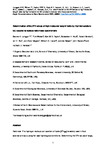Determination of the δ 2 H values of high molecular weight lipids by high temperature GC coupled to isotope ratio mass spectrometry
| dc.contributor.author | Lengger, SK | |
| dc.contributor.author | Weber, Y | |
| dc.contributor.author | Taylor, KWR | |
| dc.contributor.author | Kopf, SH | |
| dc.contributor.author | Berstan, R | |
| dc.contributor.author | Bull, ID | |
| dc.contributor.author | Mayser, J | |
| dc.contributor.author | Leavitt, WD | |
| dc.contributor.author | Blewett, J | |
| dc.contributor.author | Pearson, A | |
| dc.contributor.author | Pancost, RD | |
| dc.date.accessioned | 2020-11-20T15:18:37Z | |
| dc.date.issued | 2020-10-17 | |
| dc.identifier.issn | 0951-4198 | |
| dc.identifier.issn | 1097-0231 | |
| dc.identifier.other | ARTN e8983 | |
| dc.identifier.uri | http://hdl.handle.net/10026.1/16666 | |
| dc.description.abstract |
Rationale The hydrogen isotopic composition of lipids (δ2Hlipid) is widely used in food science and as a proxy for past hydrological conditions. Determining the δ2H values of large, well-preserved triacylglycerides and other microbial lipids, such as glycerol dialkyl glycerol tetraether (GDGT) lipids, is thus of widespread interest but has so far not been possible due to their low volatility which prohibits analysis by traditional gas chromatography/pyrolysis/isotope ratio mass spectrometry (GC/P/IRMS). Methods We determined the δ2H values of large, polar molecules and applied high-temperature gas chromatography (HTGC) methods on a modified GC/P/IRMS system. The system used a high-temperature 7-m GC column, and a glass Y-splitter for low thermal mass. Methods were validated using authentic standards of large, functionalised molecules (triacylglycerides, TGs), purified standards of GDGTs. The results were compared with δ2H values determined by high-temperature elemental analyser/pyrolysis/isotope ratio mass spectrometry (HTEA/P/IRMS), and subsequently applied to the analysis of GDGTs in a sample from a methane seep and a Welsh peat. Results The δ2H values of TGs agreed within error between HTGC/P/IRMS and HTEA/IRMS, with HTGC/P/IRMS showing larger errors. Archaeal lipid GDGTs with up to three cyclisations could be analysed: the δ2H values were not significantly different between methods with standard deviations of 5 to 6 ‰. When environmental samples were analysed, the δ2H values of isoGDGTs were 50 ‰ more negative than those of terrestrial brGDGTs. Conclusions Our results indicate that the HTGC/P/IRMS method developed here is appropriate to determine the δ2H values of TGs, GDGTs with up to two cyclisations, and potentially other high molecular weight compounds. The methodology will widen the current analytical window for biomarker and food light stable isotope analyses. Moreover, our initial measurements suggest that bacterial and archaeal GDGT δ2H values can record environmental and ecological conditions. | |
| dc.format.extent | e8983- | |
| dc.format.medium | ||
| dc.language | en | |
| dc.language.iso | en | |
| dc.publisher | Wiley | |
| dc.subject | Archaea | |
| dc.subject | Bacteria | |
| dc.subject | Deuterium | |
| dc.subject | Gas Chromatography-Mass Spectrometry | |
| dc.subject | Lipids | |
| dc.subject | Molecular Weight | |
| dc.subject | Soil | |
| dc.subject | Temperature | |
| dc.title | Determination of the δ 2 H values of high molecular weight lipids by high temperature GC coupled to isotope ratio mass spectrometry | |
| dc.type | journal-article | |
| dc.type | Article | |
| plymouth.author-url | https://www.ncbi.nlm.nih.gov/pubmed/33068049 | |
| plymouth.issue | 4 | |
| plymouth.volume | 35 | |
| plymouth.publication-status | Published | |
| plymouth.journal | Rapid Communications in Mass Spectrometry | |
| dc.identifier.doi | 10.1002/rcm.8983 | |
| plymouth.organisational-group | /Plymouth | |
| plymouth.organisational-group | /Plymouth/Faculty of Science and Engineering | |
| plymouth.organisational-group | /Plymouth/REF 2021 Researchers by UoA | |
| plymouth.organisational-group | /Plymouth/REF 2021 Researchers by UoA/UoA07 Earth Systems and Environmental Sciences | |
| dc.publisher.place | England | |
| dcterms.dateAccepted | 2020-10-16 | |
| dc.rights.embargodate | 2021-10-17 | |
| dc.identifier.eissn | 1097-0231 | |
| dc.rights.embargoperiod | Not known | |
| rioxxterms.versionofrecord | 10.1002/rcm.8983 | |
| rioxxterms.licenseref.uri | http://www.rioxx.net/licenses/all-rights-reserved | |
| rioxxterms.licenseref.startdate | 2020-10-17 | |
| rioxxterms.type | Journal Article/Review |



